Introduction to h3jsr
Lauren O’Brien
2024-01-10
Source:vignettes/intro-to-h3jsr.Rmd
intro-to-h3jsr.Rmd
local_options <- options()
library(sf)
library(dplyr)
library(ggplot2)
library(h3jsr)
# for R < 4, since H3 addresses are handled as strings
options(stringsAsFactors = FALSE)General information
h3jsr connects Uber’s H3 geospatial library to R, via its transpiled
JavaScript implementation,h3-js. The library has extensive
potential applications in network analysis, trip routing, and geospatial
data aggregation. The wrapper functions provided are intended to
interface well with the existing R-spatial ecosystem, particularly
sf.
- Documentation for the core H3 library is at H3’s github page.
- The core library only understands WGS84 coordinates, so multiple
projection support is limited. All spatial objects are returned in
WGS84, and ideally should be supplied as such. It’s always safer to do
your own spatial transformations and verify the results. If spatial data
in a coordinate system other than WGS84 is supplied, it is transformed
using
sf::st_transform()and a message is issued. - For each function in
h3jsr, the default behaviour is to return data in as simple a structure as is practical, but there is always an option to return a more complex-object containing both input and output data, as appropriate for the function in question. - This package uses
V8to interface withh3-js. As such, a lot of the overhead for each function call is related to sending data to and from V8 via JSON conversion. Feeding large datasets in often gives faster results than one might expect from the toy examples below. Avoid using these functions in conjunction with e.g.base::lapplyorpurrr::mapon individual geometries!
Core Functions
Nine core functions exist - three for translating spatial data into and out of the H3 system, and six information utilities, including an address validity checker.
point_to_cell() takes in sf-style point
data and will return the address each point falls into. You can extract
addresses for one resolution or many. This function will also accept a
matrix or data frame as input, but this will only work if columns 1 and
2 contain WGS84 longitude and latitude values, respectively.
# This is the location of the Brisbane Town Hall:
bth <- sf::st_sfc(sf::st_point(c(153.023503, -27.468920)), crs = 4326)
# where is the Brisbane Town Hall at resolution 15?
point_to_cell(bth, res = 15)
#> [1] "8fbe8d12acad2f3"By default, a character vector is returned for a single resolution,
and a data frame where multiple resolutions are requested. If
simple = FALSE and the input object inherits from
data.frame, a data frame object is returned with a new
attribute column for each resolution requested.
nc <- st_read(system.file("shape/nc.shp", package="sf"), quiet = TRUE)
nc_pts <- st_centroid(nc)
nc_pts <- st_transform(nc_pts, crs = 4326)
nc_pts <- dplyr::select(nc_pts, CNTY_ID, NAME)
# Give me the address for the center of each NC county at every resolution
nc_all_res <- point_to_cell(nc_pts, res = seq(0, 15), simple = FALSE)
head(nc_all_res[, c(1:5)])
#> CNTY_ID NAME h3_resolution_0 h3_resolution_1 h3_resolution_2
#> 1 1825 Ashe 802bfffffffffff 812abffffffffff 8244dffffffffff
#> 2 1827 Alleghany 802bfffffffffff 812abffffffffff 8244dffffffffff
#> 3 1828 Surry 802bfffffffffff 812abffffffffff 822a8ffffffffff
#> 4 1831 Currituck 802bfffffffffff 812afffffffffff 822af7fffffffff
#> 5 1832 Northampton 802bfffffffffff 812afffffffffff 822af7fffffffff
#> 6 1833 Hertford 802bfffffffffff 812afffffffffff 822af7fffffffffH3 addresses can be translated back to a point at a given resolution
with cell_to_point(). A polygon (almost always a hexagon),
can be retrieved with cell_to_polygon().
# plot a few
ashe_hexes <- unlist(nc_all_res[1, c(6,7,8,9,10)], use.names = FALSE)
ashe_hexes <- cell_to_polygon(ashe_hexes, simple = FALSE)
ggplot(nc[1,]) +
geom_sf(fill = NA, colour = 'black') +
geom_sf(data = ashe_hexes, aes(fill = h3_address), alpha = 0.5) +
scale_fill_viridis_d() +
ggtitle('H3 hexagons over County Ashe, NC', subtitle = 'Resolutions 6-10') +
theme_minimal() +
coord_sf()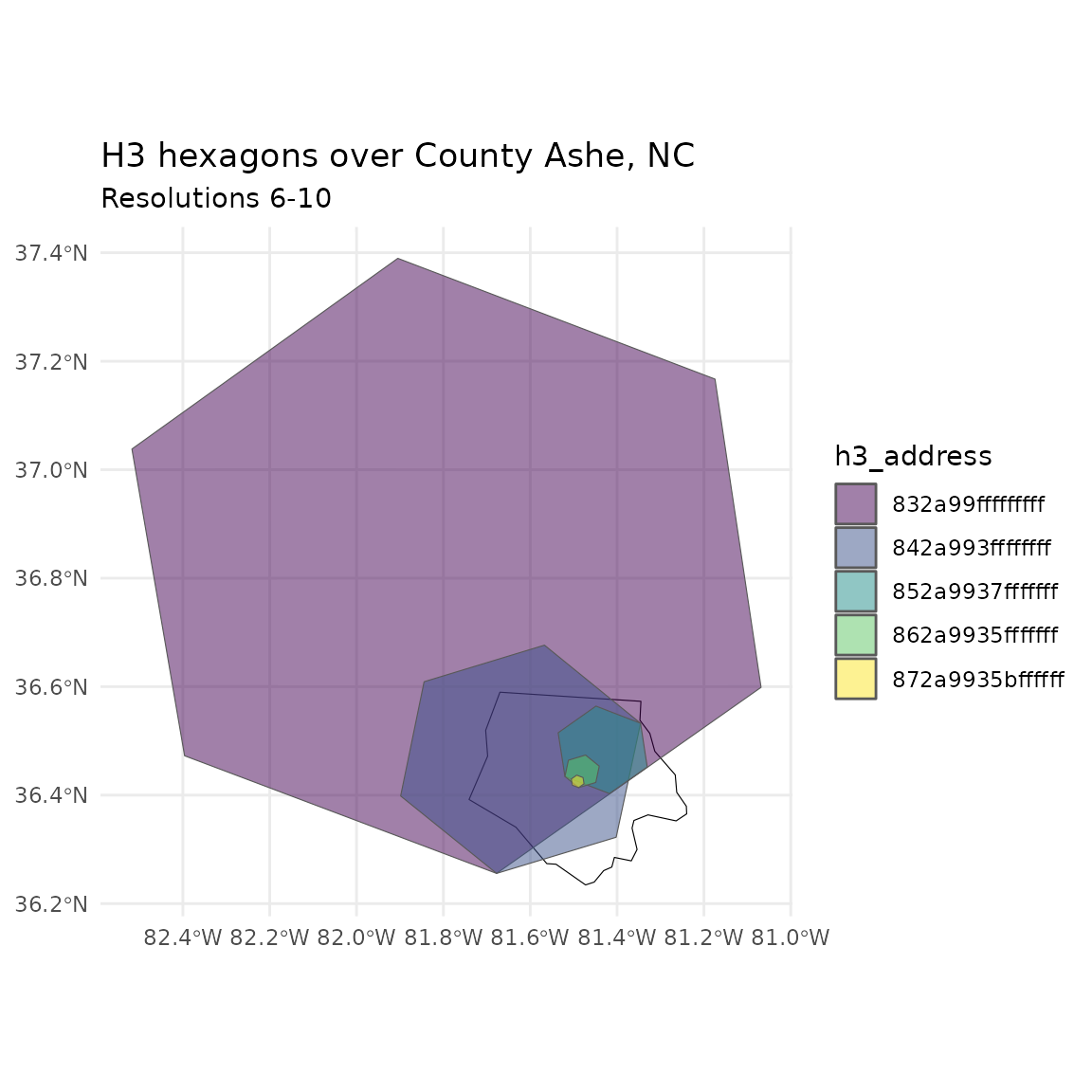
Hopefully the above plot gives a sense of the large scale changes between resolution levels - each level is seven times more detailed than the last.
H3 address validity checks are done with is_valid():
is_valid(h3_address = '8abe8d12acaffff')
#> [1] TRUE
is_valid(h3_address = '8abe8d12aca')
#> [1] FALSEYou can check whether an address refers to one of the pentagons that
occur on icosahedron corners at each resolution with
is_pentagon(). This is relevant where subsequent area or
distance calculations will be carried out. All of the pentagon indices
for a given resolution can be identified using
get_pentagons().
# is the following address a pentagon?
is_pentagon(h3_address = '8abe8d12acaffff')
#> [1] FALSE
get_pentagons(res = 8)
#> [[1]]
#> [1] "8808000001fffff" "881c000001fffff" "8830000001fffff" "884c000001fffff"
#> [5] "8862000001fffff" "8874000001fffff" "887e000001fffff" "8890000001fffff"
#> [9] "88a6000001fffff" "88c2000001fffff" "88d6000001fffff" "88ea000001fffff"
ggplot() +
geom_sf(data = cell_to_polygon(get_pentagons(8)[[1]][1]), fill = NA) +
theme_void()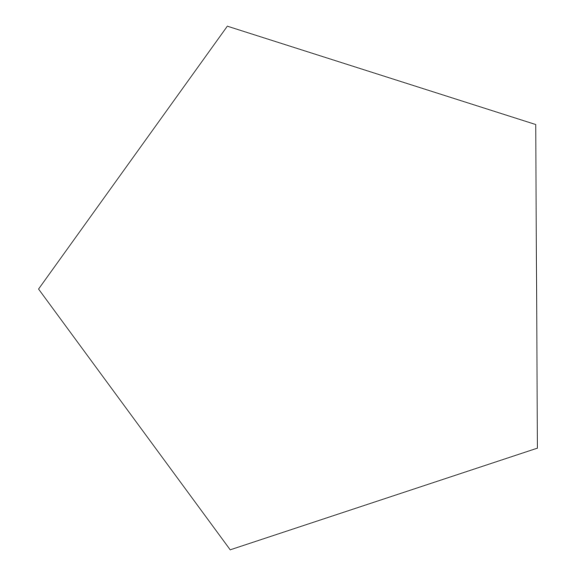
is_rc3() checks whether an H3 address has a resolution
with Class III orientation. This refers to the orientation of
the hex grid relative to the next coarser resolution.
is_rc3(h3_address = '8abe8d12acaffff')
#> [1] FALSEThe number of the base (resolution-0) cell for any H3 address can be
retrieved with get_base_cell(). These run from 0 at the
North Pole to 121 at the South.
get_base_cell(h3_address = '8abe8d12acaffff')
#> [1] 95The triangular icosahedron face (or faces) that a cell belongs to can
also be retrieved with get_faces(). These run 1-20, North
to South.
get_faces(h3_address = '8abe8d12acaffff')
#> [1] 15Lastly, the resolution of an H3 address can be retrieved with
get_res().
get_res(h3_address = '8abe8d12acaffff')
#> [1] 10Neighbour Algorithms
As the H3 grid system is hierarchical, addresses have parents and children. A parent address is the one that contains the given address at a coarser resolution. A child address is contained by the given address. Parents and children can be requested at any resolution above and below the input, respectively.
# input is res 10:
get_parent(h3_address = '8abe8d12acaffff', res = 6)
#> [1] "86be8d12fffffff"
# input is res 6:
get_children(h3_address = '86be8d12fffffff', res = 7)
#> [[1]]
#> [1] "87be8d128ffffff" "87be8d129ffffff" "87be8d12affffff" "87be8d12bffffff"
#> [5] "87be8d12cffffff" "87be8d12dffffff" "87be8d12effffff"
ggplot() +
geom_sf(data = cell_to_polygon('86be8d12fffffff'), fill = NA) +
geom_sf(data = cell_to_polygon(get_children(h3_address = '86be8d12fffffff',
res = 7)[[1]]),
fill = 'red', alpha = 0.5 ) +
theme_void()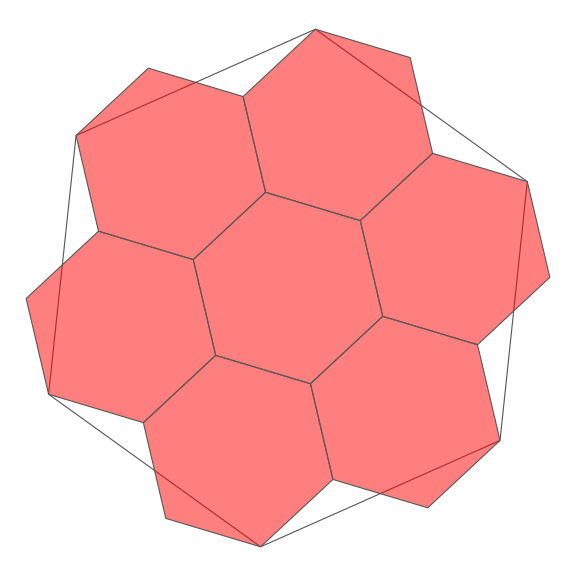
The number of addresses returned for each request is
7 ^ (parent_res - child_res), so jumping three levels will
return 343 addresses for a single input, and that’s about 41 kb.
To return only the central child for a given address, use
get_centerchild():
# input is res 6:
get_centerchild(h3_address = '86be8d12fffffff', res = 7)
#> [1] "87be8d128ffffff"
ggplot() +
geom_sf(data = cell_to_polygon('86be8d12fffffff'), fill = NA) +
geom_sf(data = cell_to_polygon(get_centerchild('86be8d12fffffff', 7)),
fill = 'red') +
geom_sf(data = cell_to_polygon(get_centerchild('86be8d12fffffff', 8)),
fill = 'blue') +
theme_void()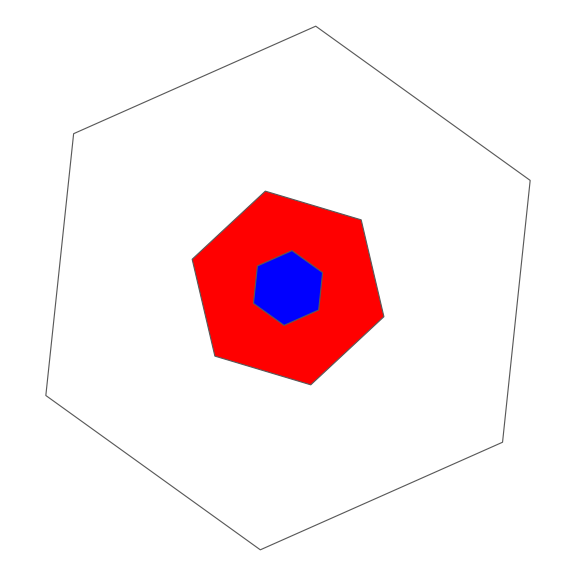
Within the same resolution, addresses within n ‘steps’ from
a central address (a ‘patch’ of hexagons) can be retrieved with
get_disk() or get_disk_list(). The latter
function returns an output where addresses are listed separately for
each step away from the input. The input address is included in the
output.
get_disk(h3_address = '86be8d12fffffff', ring_size = 2)
#> [[1]]
#> [1] "86be8d12fffffff" "86be8d127ffffff" "86be8d107ffffff" "86be8d10fffffff"
#> [5] "86be8d177ffffff" "86be8d8dfffffff" "86be8d8d7ffffff" "86be8d88fffffff"
#> [9] "86be8d89fffffff" "86be8d137ffffff" "86be8d117ffffff" "86be8d11fffffff"
#> [13] "86be8d027ffffff" "86be8d157ffffff" "86be8d147ffffff" "86be8d167ffffff"
#> [17] "86be8d8cfffffff" "86be8d8c7ffffff" "86be8d8f7ffffff"
get_disk_list(h3_address = '86be8d12fffffff', ring_size = 2)
#> [[1]]
#> [[1]][[1]]
#> [1] "86be8d12fffffff"
#>
#> [[1]][[2]]
#> [1] "86be8d127ffffff" "86be8d107ffffff" "86be8d10fffffff" "86be8d177ffffff"
#> [5] "86be8d8dfffffff" "86be8d8d7ffffff"
#>
#> [[1]][[3]]
#> [1] "86be8d88fffffff" "86be8d89fffffff" "86be8d137ffffff" "86be8d117ffffff"
#> [5] "86be8d11fffffff" "86be8d027ffffff" "86be8d157ffffff" "86be8d147ffffff"
#> [9] "86be8d167ffffff" "86be8d8cfffffff" "86be8d8c7ffffff" "86be8d8f7ffffff"A ring of addresses at exactly n steps is obtained with
get_ring().
get_ring(h3_address = '86be8d12fffffff', ring_size = 2)
#> [[1]]
#> [1] "86be8d8f7ffffff" "86be8d88fffffff" "86be8d89fffffff" "86be8d137ffffff"
#> [5] "86be8d117ffffff" "86be8d11fffffff" "86be8d027ffffff" "86be8d157ffffff"
#> [9] "86be8d147ffffff" "86be8d167ffffff" "86be8d8cfffffff" "86be8d8c7ffffff"These address lists can all be spatialised with
cell_to_multipolygon(), which returns the polygonised
outline of a collection of H3 addresses.
disk <- get_disk(h3_address = '86be8d12fffffff', ring_size = 2)
ring <- get_ring(h3_address = '86be8d12fffffff', ring_size = 5)
patch_sf <- cells_to_multipolygon(disk, simple = FALSE)
donut_sf <- cells_to_multipolygon(ring, simple = FALSE)
ggplot() +
geom_sf(data = patch_sf, alpha = 0.5) +
theme_minimal() +
geom_sf(data = donut_sf, alpha = 0.5, fill = 'red') +
theme_void()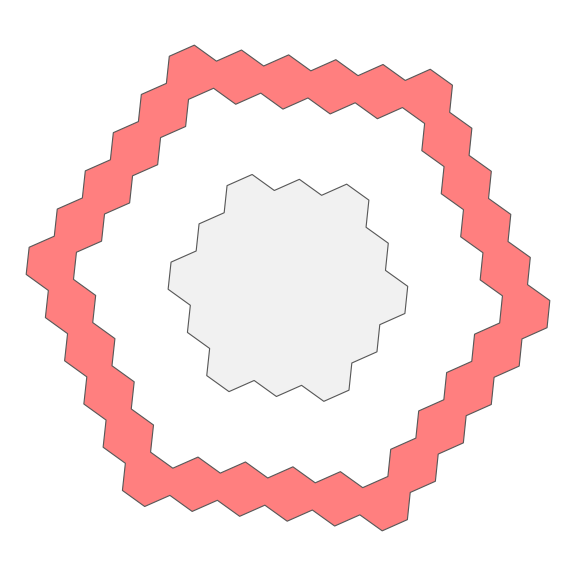
But it may be more interesting to use
cell_to_polygon()
disk_singles <- cell_to_polygon(unlist(disk, use.names = FALSE), simple = FALSE)
ring_singles <- cell_to_polygon(unlist(ring, use.names = FALSE), simple = FALSE)
ggplot(disk_singles) +
geom_sf(aes(fill = 1:nrow(disk_singles)), show.legend = FALSE) +
scale_fill_viridis_c() +
theme_minimal() +
theme_void()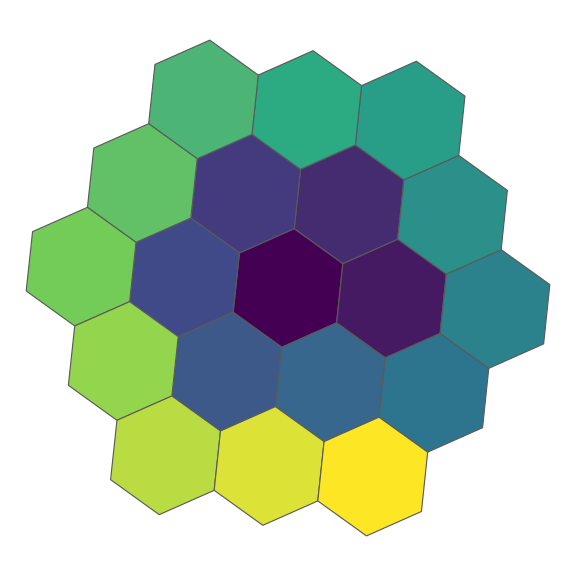
ggplot(ring_singles) +
geom_sf(aes(fill = 1:nrow(ring_singles)), show.legend = FALSE) +
scale_fill_viridis_c() +
theme_minimal() +
theme_void()
polygon_to_cells() will return all the h3 addresses
whose centers intersect a given polygon. Multipolygons are supported as
well.
ashe <- st_transform(nc[1, ], crs = 4326)
ashe_7 <- polygon_to_cells(ashe, res = 7, simple = FALSE)
ashe_7 <- cell_to_polygon(unlist(ashe_7$h3_addresses), simple = FALSE)
ggplot() +
geom_sf(data = ashe, fill = NA) +
geom_sf(data = ashe_7, fill = NA, colour = 'red') +
ggtitle('Resolution 7 hexagons', subtitle = 'County Ashe, NC') +
theme_minimal() +
coord_sf()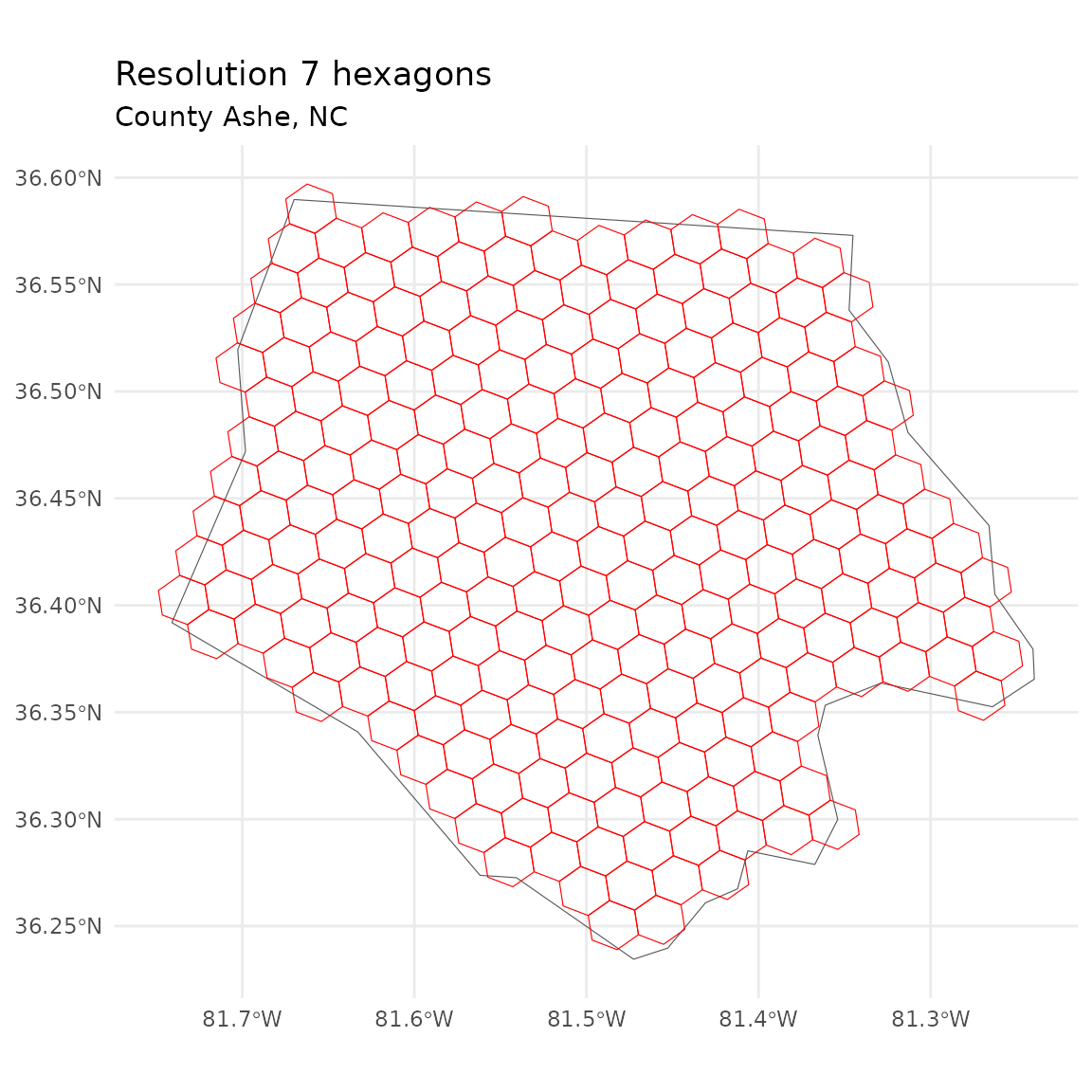
A representation like this can be ‘compacted’ with
compact().
ashe_comp <- compact(ashe_7$h3_address)
ashe_comp <- cell_to_polygon(ashe_comp, simple = FALSE)
ggplot() +
geom_sf(data = ashe, fill = NA) +
geom_sf(data = ashe_comp, fill = NA, colour = 'red') +
ggtitle('Compacted hexes from resolution 7', subtitle = 'County Ashe, NC') +
theme_minimal() +
coord_sf()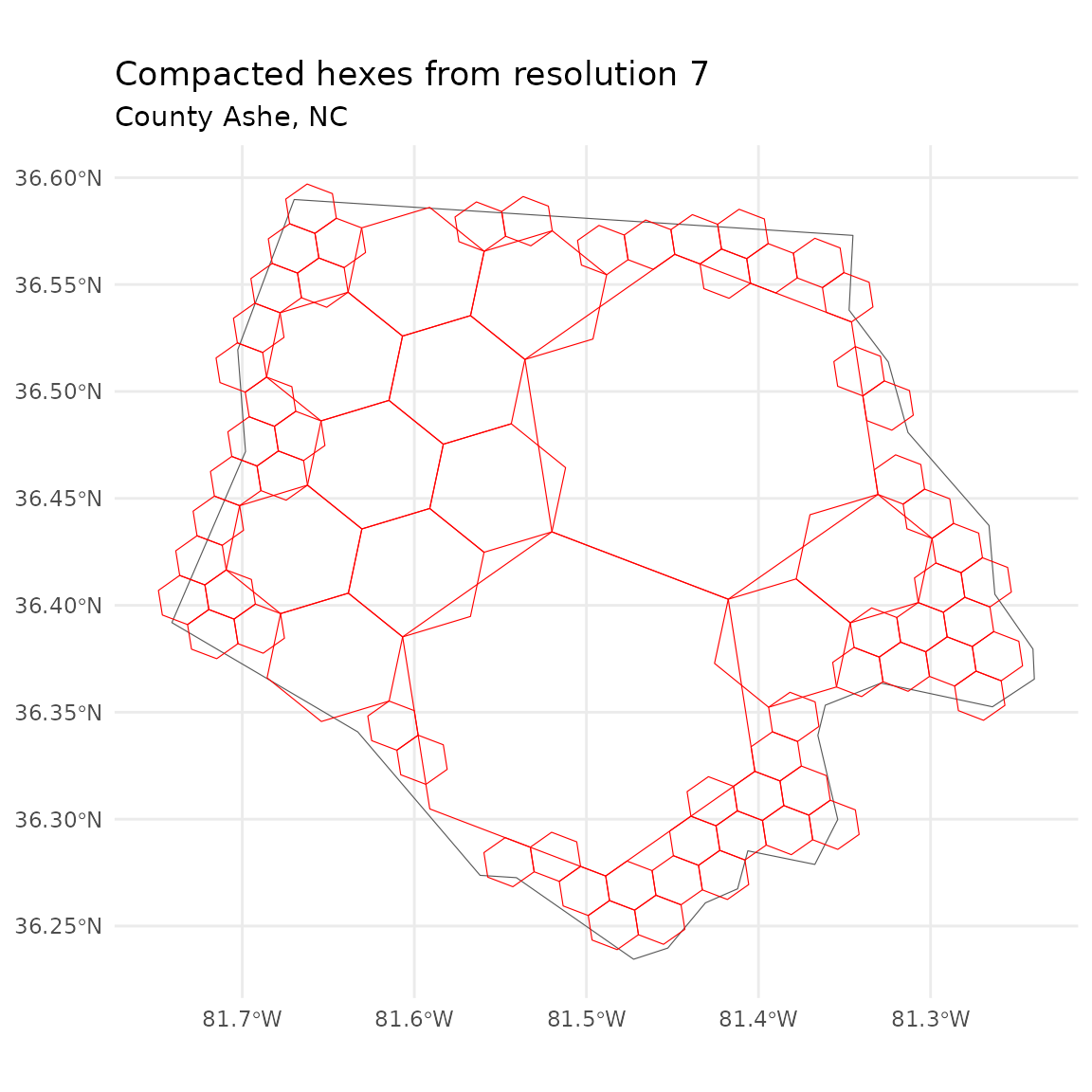
Note the orientation shift at each resolution change. A compacted
representation can be uncompacted back to any resolution with
uncompact(), with some loss when the chosen resolution is
more detailed than the original polygon_to_cells()
operation.
ashe_comp <- compact(ashe_7$h3_address)
ashe_uncomp <- uncompact(ashe_comp, res = 8)
ashe_uncomp <- cell_to_polygon(ashe_uncomp, simple = FALSE)
ggplot() +
geom_sf(data = ashe, fill = NA) +
geom_sf(data = ashe_uncomp, fill = NA, colour = 'red') +
theme_minimal() +
ggtitle('Uncompacted hexes to resolution 8', subtitle = 'County Ashe, NC') +
coord_sf()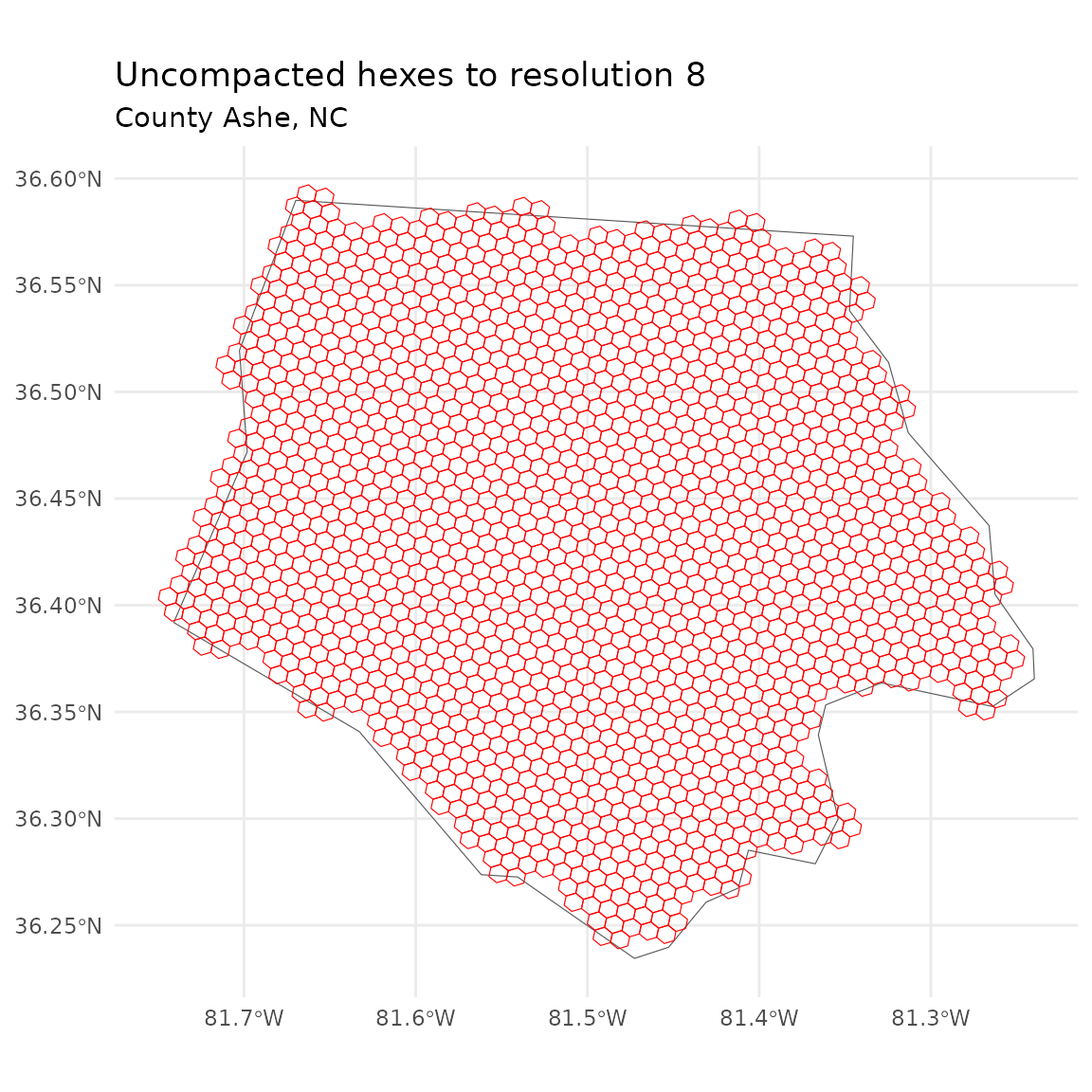
Unidirectional edges
To check whether two H3 addresses share an edge, use
are_neighbours():
# Are the following addresses neighbours?
are_neighbours(origin = '86be8d12fffffff', destination = '86be8d127ffffff')
#> [1] TRUE
are_neighbours(origin = '86be8d12fffffff', destination = '86be8d147ffffff')
#> [1] FALSE
ggplot() +
geom_sf(data = cell_to_polygon(c('86be8d12fffffff')),
fill = c('red'), alpha = 0.5) +
geom_sf(data = cell_to_polygon(c('86be8d127ffffff')),
fill = c('blue'), alpha = 0.5) +
geom_sf(data = cell_to_polygon(c('86be8d147ffffff')),
fill = c('green'), alpha = 0.5) +
theme_void()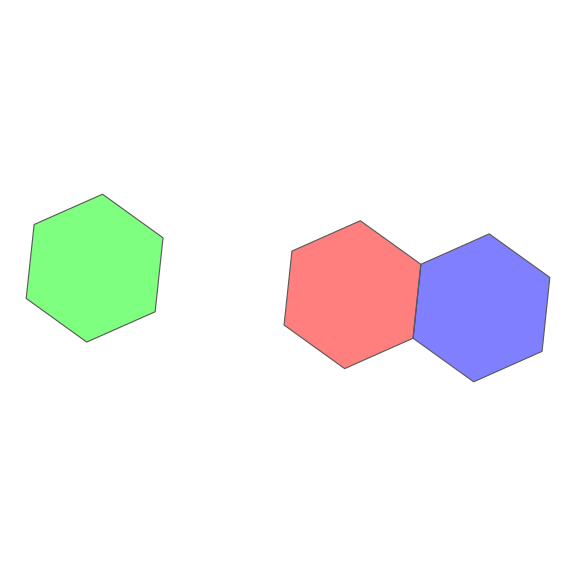
The H3 system can also generate addresses for hex edges. To get the
address representing the edge between to adjacent H3 addresses, use
get_udedge(). Note that the resultant address looks a
little different, and has its own validity checking function,
is_valid_edge():
# Get me the edge between these two addresses
get_udedge(origin = '86be8d12fffffff', destination = '86be8d127ffffff')
#> [1] "166be8d12fffffff"
is_valid_edge('166be8d12fffffff')
#> [1] TRUE
# not neighbours:
#get_udedge(origin = '86be8d12fffffff', destination = '86be8d147ffffff')The edge address can also be used to retrieve its origin and destination hex addresses, separately or together:
get_udorigin(h3_edge = '166be8d12fffffff')
#> [1] "86be8d12fffffff"
get_uddest(h3_edge = '166be8d12fffffff')
#> [1] "86be8d127ffffff"
get_udends(h3_edge = '166be8d12fffffff')
#> [[1]]
#> [1] "86be8d12fffffff" "86be8d127ffffff"To get all the edges of a given H3 address, use
get_udedges(). Edges can be converted to
sfc_LINESTRING geometries with
udedge_to_line():
get_udedges(h3_address = '86be8d12fffffff')
#> [[1]]
#> [1] "116be8d12fffffff" "126be8d12fffffff" "136be8d12fffffff" "146be8d12fffffff"
#> [5] "156be8d12fffffff" "166be8d12fffffff"
ggplot() +
geom_sf(data = cell_to_polygon('86be8d12fffffff'), col = NA) +
geom_sf(data = udedge_to_line(get_udedges(h3_address = '86be8d12fffffff')[[1]]),
aes(col = seq(6)), size = 2, show.legend = FALSE) +
scale_color_viridis_c() +
theme_void()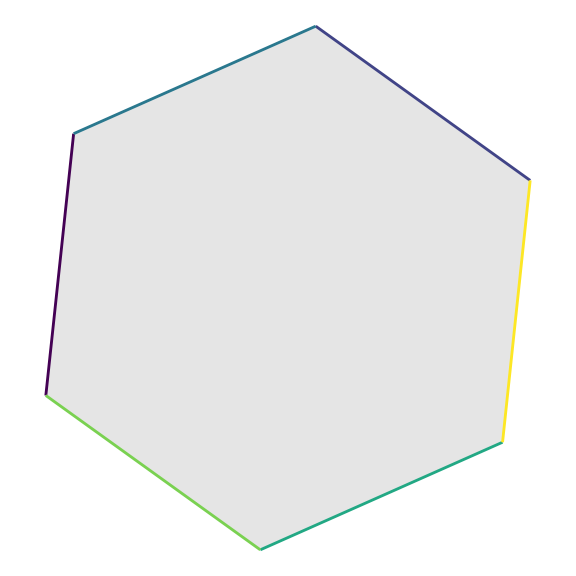
Vertexes
H3 v4.0+ can return addresses for cell corner vertices, which again have their own validity checker.
vtx0 <- vertex_to_point(get_cell_vertex('86be8d12fffffff', 0), simple = FALSE)
vtxs <- vertex_to_point(get_cell_vertexes('86be8d12fffffff')[[1]], simple = FALSE)
poly <- cell_to_polygon('86be8d12fffffff', simple = FALSE)
is_valid_vertex(get_cell_vertex('86be8d12fffffff', 0))
#> [1] TRUE
ggplot() +
geom_sf(data = poly, col = NA) +
geom_sf(data = vtxs, aes(col = seq(6)), size = 3, show.legend = FALSE) +
geom_sf(data = vtx0, col = 'red', size = 5, pch = 1, show.legend = FALSE) +
scale_color_viridis_c() +
theme_void()
Local coordinates
Functions get_local_ij() and get_local_h3()
can be used to map H3 addresses to a 2-axis coordinate space, relative
to a given origin address. These functions are experimental and are
likely to change in future.
local <- get_local_ij(origin = '86be8d12fffffff',
destination = '86be8d127ffffff')
get_local_cell(origin = '86be8d12fffffff', i = local[, 1], j = local[, 2])
#> [1] "86be8d127ffffff"Distance and Direction
Within the context of the H3 grid system, functions
grid_distance() and grid_path() provide some
‘navigational’ functionality. grid_distance() will report
how many steps through the grid are required to travel from one address
to another. grid_path() will return a list of addresses
that traverse a shortest path. Note that multiple minimum-step pathways
will be possible for many sets of addresses, but this function should
return the same one consistently.
nc_pts <- sf::st_centroid(nc[c(1, 2), ])
nc_6 <- point_to_cell(nc_pts, res = 6)
# how far apart are these two addresses?
grid_distance(nc_6[1], nc_6[2])
#> [1] 6
# find a path between these two addresses:
path <- grid_path(nc_6[1], nc_6[2], simple = TRUE)
path
#> [[1]]
#> [1] "862a9935fffffff" "862a9934fffffff" "862a9936fffffff" "8644db267ffffff"
#> [5] "8644db277ffffff" "8644db257ffffff" "8644db2e7ffffff"Note that these functions only work between grid cells at the same resolution.
The great-circle distance between two points (e.g. cell centers) can
also be calculated with get_dist(), using the Haversine
formula.
cell_to_line() is a custom function that has been
provided largely to make it easy to spatialise the results of
grid_path(). It will take a list of h3 addresses, convert
them to points, and then turn the set of points into an
sfc_LINESTRING object. The function is flexible enough to
work across an arbitrary set of addresses (including addresses at
multiple resolutions), but this is untested and results may be
strange.
state_line <- cell_to_line(path)
ggplot() +
geom_sf(data = nc[c(1,2), ], fill = NA) +
geom_sf(data = sf::st_centroid(nc[c(1,2), ]), pch = 19, size = 2) +
geom_sf(data = cell_to_point(nc_6), pch = 19, size = 2, col = 'red') +
geom_sf(data = cell_to_polygon(nc_6), fill = NA) +
geom_sf(data = state_line, fill = NA, colour = 'red') +
theme_minimal() +
ggtitle('Counties Ashe and Alleghany, NC', subtitle = 'Line connecting hexagons containing centroids at resolution 6') +
coord_sf()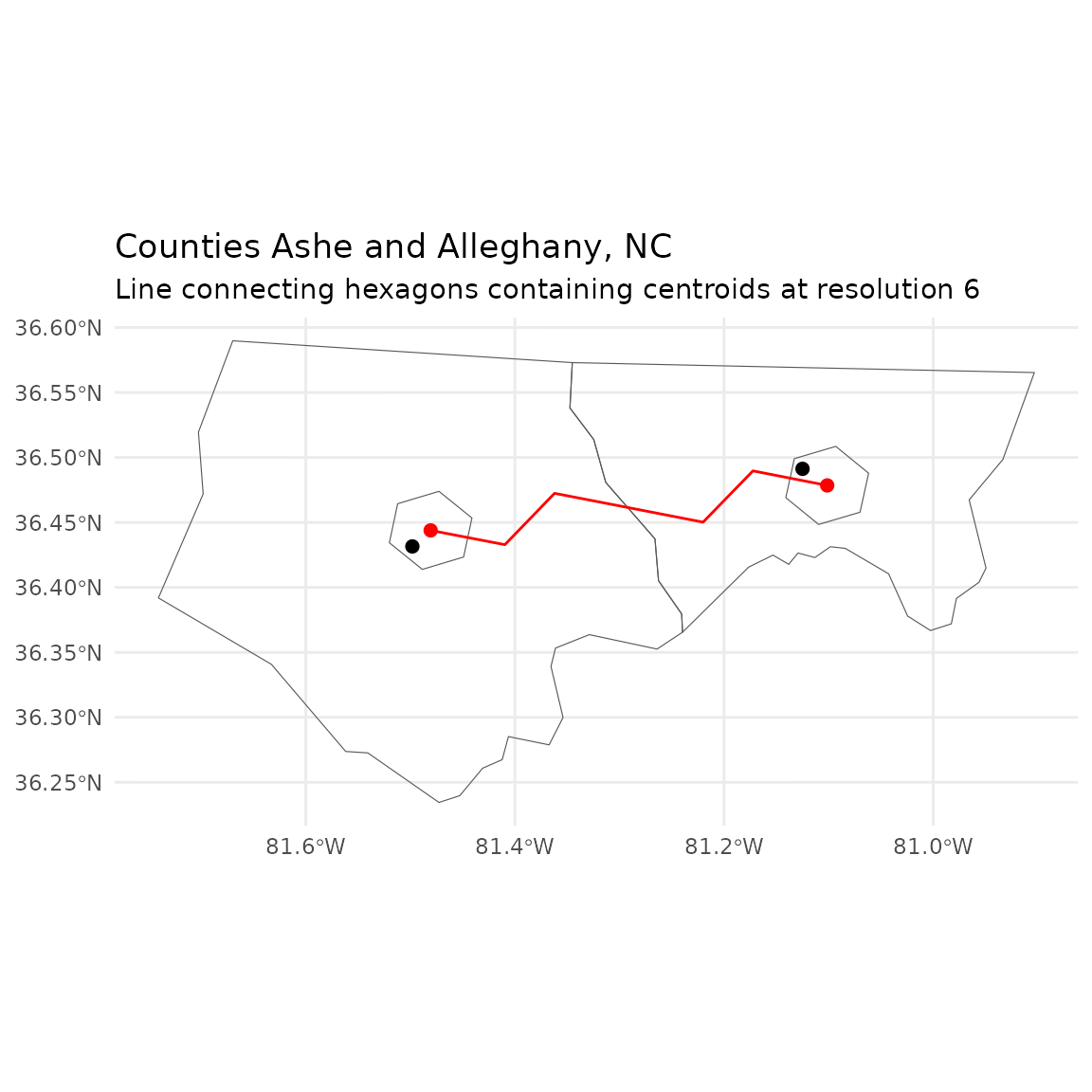
Info utilities
A set of general information utilities give information about the characteristics of the hexagons at each resolution. This includes average area, average edge length, average distance between hexagon centers, and the total number of addresses. This data is stored locally but can also be calculated from source.
res_area(6, 'km2')
#> [1] 36.12906
res_length(6, 'km')
#> [1] 3.229483
res_cendist(6, 'km')
#> [1] 5.593628
num_cells(6)
#> [1] 14117882
data("h3_info_table")
str(h3_info_table)
#> 'data.frame': 16 obs. of 8 variables:
#> $ h3_resolution : int 0 1 2 3 4 5 6 7 8 9 ...
#> $ avg_area_sqm : num 4.36e+12 6.10e+11 8.68e+10 1.24e+10 1.77e+09 ...
#> $ avg_area_sqkm : num 4357449 609788 86802 12393 1770 ...
#> $ avg_edge_m : num 1107713 418676 158245 59811 22606 ...
#> $ avg_edge_km : num 1107.7 418.7 158.2 59.8 22.6 ...
#> $ avg_cendist_m : num 1918614 725168 274088 103595 39155 ...
#> $ avg_cendist_km : num 1918.6 725.2 274.1 103.6 39.2 ...
#> $ total_unique_indexes: num 122 842 5882 41162 288122 ...The exact area of particular cells and the length of edges can also be calculated:
cell_area(h3_address = '8abe8d12acaffff', 'km2')
#> [1] 0.0177539
edge_length(h3_edge = '166be8d12fffffff', 'km')
#> [1] 4.037687Conversion utilities
Functions are available to convert H3 addresses from 64-bit hexadecimal strings to pairs of 32-bit integers, and vice versa:
x <- cell_to_splitlong(h3_address = '8abe8d12acaffff')
y <- splitlong_to_cell(split_lower = x[[1]][1], split_upper = x[[1]][2])
x
#> [[1]]
#> [1] 717946879 145483985
y
#> [1] "8abe8d12acaffff"Lastly, convenience functions are available for converting between degrees and radians. These are implemented in base R by default, as the results are identical and obtained much faster. The H3 functions remain accessible for testing.
degs_to_rads(120)
#> [1] 2.094395
rads_to_degs(1.5)
#> [1] 85.94367
# reset local options
options(local_options)